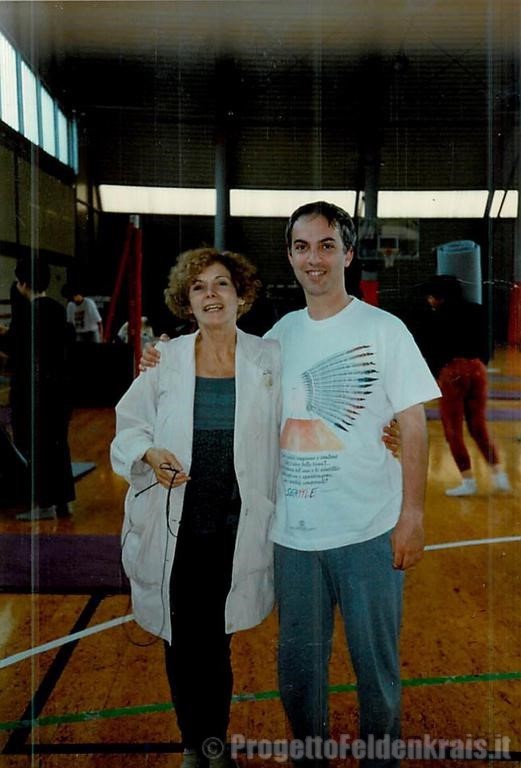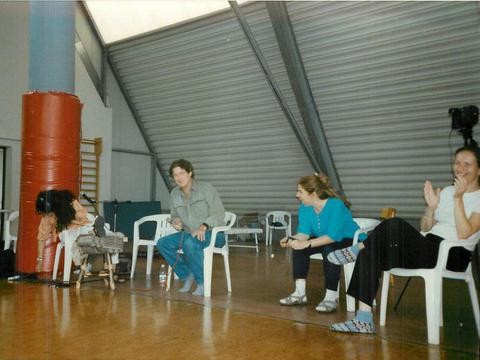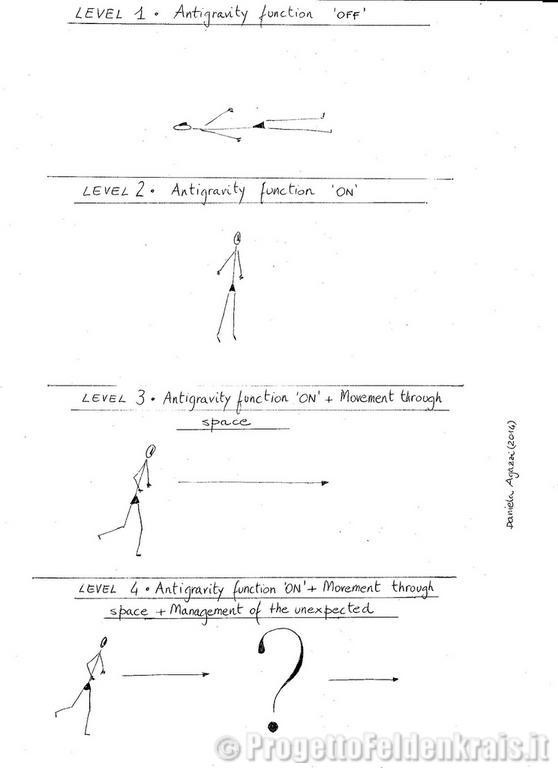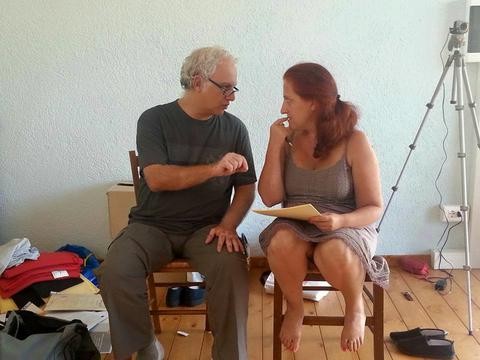New Horizons and Futures for Bones For Life

In May 2014 in Israel Raffaele Rambaldi was certified - directly by Ruthy Alon - Movement Intelligence Senior Trainer.
This article was written by Raffaele Rambaldi on the occasion of the participation in the Movement Intelligence Senior Trainers Training with Ruthy Alon in Israel in May 2014.
The English translation is also published on the Ruthy Alon website www.movementintelligence.com.
Article by Raffaele Rambaldi
Normally, when I am asked to introduce Bones For Life to the public, I describe it as a programme for ‘stimulating the strengthening of the bones and improving postural realignment through natural movement’.
This first simple definition has the advantage of evoking from the start two themes, posture and strengthening bones, which are not only easily understandable and recognisable by anyone, but which are particularly heard about nowadays.
Of course there is much more to it. I fully realise that in my introductions I go back to an explanatory simplification because I am well aware of the implications and the powerful repercussions of the Bones For Life programme on the improvement of quality of life not just at the physical level but also at the psychological, relational, emotional and energy levels.
In fact, although historically Bones For Life was developed to manage, prevent and tackle particularly the deeply-felt and diffuse problems linked to weakening of the bones, we are increasingly realising the extent to which its potential and applications are wide, powerful and for the most part still waiting to be developed. I like to think of Bones For Life as a revolutionary microchip, something small and powerful that can improve everything it is applied to; that can speed up a computer, make astronauts fly and at the same time give us better refrigerators and cars. I believe that we are only scratching the surface of the potential of this system.
But let’s go through it in an orderly fashion.
It is some time since it was first understood how much responsibility for many of our most socially diffuse problems and painful conditions, including weakening of the bones, can be traced back to our ‘civilized western’ way of life.
We can see for ourselves how much every technological innovation tends to weaken our motor skills, and we are becoming lazier as each day passes, progressively reducing our motor capacity. The consequences of a progressive and apparently irreversible adaptation to an unnatural lifestyle in which the mind becomes used too much (and badly) and the body too little (and badly) can be devastating for our bones and for our health in general.
To reverse the tendency it becomes essential therefore to know how to find or create new opportunities for movement in our daily life which allow us to be able to keep the ‘human machine’ efficient so that it does not degenerate from ‘lack of use’ or break down from ‘misuse’.
The idea that physical movement is good for the bones is not a new one. But, to really work, the movement must have some particular indispensable characteristics and qualities linked to rhythmic pressure and the amount of force, in order to be able to evoke and resonate with the primary modalities of function of the body in the gravitational field such as walking, running, carrying weights and jumping, that is all those activities which naturally require the body to strengthen the bones.
So it is not enough to ‘move’ and ‘exercise' indiscriminately. The movement must be able to stimulate the organism, giving it a ‘functional' motive able to stimulate and activate the natural processes of bone strengthening. Something which does not happen, for instance, to astronauts who work in space, an environment which allows the body maximum liberty of movement but which, as it does not require a stimulating interaction with gravity, does not generate in the organism the functional need to strengthen its bones.
The inevitable consequence of this, and one which has caused NASA several problems, is that astronauts return to earth particularly weakened not just in their muscles but also in their bones. The principle ‘Use it or lose it’ proves itself true.
In nature activities such as walking, running, jumping and carrying weights, and generally anything which resonates with the rhythmic and elastic pressure of a dynamic walk go towards stimulating the organism to strengthen its own bones.
Unfortunately lack of movement causes bone weakness which in turn causes further reductions in movement. It is a vicious circle which is not easy to break. Also because to this is added other elements which must be managed in order to have the regenerative effect on the body; firstly the problem of the amount of force and rhythmic pressure (too little does not stimulate, too much causes damage) and then the problem relating to the creation of what we call the ‘Domino Effect’, that powerful lining up of the structure, in which pressure can run from one end to the other, without being trapped in any joint creating attrition, compression or deviation.
Ruthy Alon’s genius allowed her to isolate the law of organic movement (rhythmic pressure and level of force) a sort of ‘homeopathic’ information bank, which contains the essence of that which a dynamic walk, a run and carrying weights stimulates the body to reorganise itself and to reinforce and realign its bones, and to create a safe and protected environment able to provide a ‘greenhouse effect’ for learning appropriate to each person’s rhythm and situation.
Anyway, although Bones For Life was born out of problems linked to bones, it would be restrictive and limiting to confine it to this field.
Over the years I have been able to note the enormous implications and powerful repercussions of this work not just at a physical level but also at the psychological, relational, emotional and energy levels of the life which I practice.
The spontaneous change in posture, the greater vitality and energy, the sense of ‘being able to do it’, the improvement in performance in every field, the increase in self confidence and the inevitable reflection of all this in social life and relationships are priceless confirmations of the value and the possibilities of this work.
But there is still more.
The idea began to roll round my head right back in the time of my first Bones For Life course with Ruthy Alon in Florence in 1999. In that course there was present, among others, the late Jack Heggie, friend and Assistant Trainer in the four years of my Feldenkrais Practitioner training. At the end of the workshop Ruthy asked each of us our opinion on the work that had been done. Jack came up to the microphone and said a few brief words which have echoed round my head for years:
'Bones For Life is the second chapter of the Feldenkrais Method'.
Wow!
What did Jack mean? Did he perhaps mean that Bones For Life was a replacement for Feldenkrais? Certainly not! Too simple, besides being wrong. And Jack was a person of few words, but always very careful and precise in what he said. He did not waste his breath or say words at random.
So what did he mean, then?

Jack Heggie at the Feldenkrais Method Training - Florence 2 (year 1997)
These words have continued for years to float around in my head, like a puzzle to be solved. And I have continued to follow this idea and its implications bit by bit as I progress in my practice.
That there is a strong link between Bones For Life and the Feldenkrais Method is obvious and undeniable. Ruthy Alon was in fact one of the first and most advanced students of Moshè Feldenkrais and in Bones For Life she openly and completely incorporated the principles of the body’s spontaneous learning which he discovered to apply them in a different context.
To understand the meaning of Jack Heggie’s phrase I had to start from here, from the relationship between the 'guiding thought’ of Feldenkrais and its relationship with the Bones For Life programme.
Anyway first of all it is necessary to understand the premises, that is what we mean by the Feldenkrais Method, a work completely elusive in its complexity, so much that sometimes it becomes quite difficult to define it.
One thing is certain: doing Feldenkrais does not mean mechanically repeating what the founder has already done, running the risk of stopping and becoming imitators, or still worse, imitators of imitators. The Method, besides, should not be understood as a therapy, let alone as a postural or corrective form of light gymnastics. Some people frame it as a work of ‘somatic education’ or ‘organic learning’. I would say that Feldenkrais is above all a way of thinking from which strategies and applications flow.
To come closer to understanding the Feldenkrais Method, then, it is necessary as much as possible to try to understand the thinking of its creator, in other words to tap into the thinking of a genius. To return to the essence of his vision and to recognise his project within it.
When I read his 1952 book Higher Judo, I was struck by these words:
‘The essential aim of Judo is to teach, help and forward adult maturity, which is an ideal state rarely reached, where a person is capable of dealing with the immediate present task before him without being hindered by earlier formed habits of thought or attitude.’
In other words, Feldenkrais considered the ability to manage and cope with the unpredictable challenges of a world in constant change, as in the original Judo of Jigoro Kano, as the sign of having reached adult maturity, in the direction of evolution and of the fullest development of the human being.
Probably he would have directed his research into movement directly and fully in this direction of an evolutionary project if he had not been disabled by the serious accident to his knee.
As many people know, in fact, in the years before the second world war he had a serious knee injury during a game of football. The orthopedic surgery of the time was not able to offer Moshe reasonable possibilities and hopes of recovery, and he decided against an operation.
Bringing together all his experience, with great determination, open mind and spirit of initiative, he began to search for and develop alternative ways of ensuring that his body could find a better way of organizing itself which would allow him to live a ‘normal’ life despite the damage to his knee. He was successful, and began walking and giving a few Judo demonstrations again.
But all this changed something in him. To solve his problem he had ended up discovering the most ancient and powerful way in which a human body learns and learns to learn. Organic Learning.
He realised that a work of ‘Somatic Education’ based on these intuitions had enormous potential. It would allow the easy and natural updating of habits of movement (and other habits); make old strategies and patterns causing pains and problems naturally obsolete, as well as opening the doors to a reawakening of the resources and the untapped potential in every human being.
His ‘evolutionary vision’; that ‘reaching full adult maturity’; that ‘rarely achieved ideal state in which a person is able to tackle the present task without being entangled by pre-existing old thought habits or attitudes’ was still the direction towards which he was heading.
But, as Goethe said, ‘once you have missed the first buttonhole you’ll never manage to button up’. And the new tools allow us to ‘start again with the first button’ and not to build on old attitudes and motor strategies which are now inadequate, not to say limiting, and in any case unproductive.
For example, to teach a form of Tai Chi Chuan you almost always start with a work in the standing position (also called the position of the ‘free’ man). In reality, for the average civilized western adult, this is anything but a neutral or ‘free’ position. Rather, the average person has already fixed and consolidated in their neurology and physiology a great number of rigid and limiting strategies and patterns which turn out to be obstacles or cause slowing down in learning the discipline which must at the same time also provide for cleaning the body of pre-existing sources of interference. It is a bit like trying to write on a sheet of paper which has previously been folded up and still has folds and creases from its former condition.
In reality our erect position, as our normal way of moving, is the result of our body’s adapting to the environment through a series of progressive acquisitions and stages, through the delicate exploratory phase of discovery and coping with the gravitational field: lying on the back, then on the belly; creeping, crawling, and finally standing up. For these reasons our standing up and our way of walking and moving are a reflection of our evolutionary motor history.
If we assume as the final project of Moshe Feldenkrais the achievement of this ‘adult maturity’ of which he speaks in Higher Judo, in the light of the above we can organise it approximately in four progressive and evolutionary levels of coping with the gravitational field.
To really get into the Feldekkrais Method it is essential to try to tune into the way of thinking of its founder, with his genius in knowing how to take abstract ideas and bring them to the level of concrete actions and experiences for people, tracing the steps and mental processes followed by him in the evolution of his thought.

In the figure the four levels are shown and arranged in a simple way which makes it easy to distinguish between them. I am now going to better explain them one by one. As much as possible I shall use simple figurative expressions which everyone can easily understand.
Level 1 – Antigravity Function ‘off’
This level represents the work starting from our being stretched out on the floor, which allows us not to be in direct opposition to gravity, as happens on the other hand in the upright position. A great example of movements and lessons of this type is collected in the video ‘Movement Nature Meant’ by Ruthy Alon. Working in this way allows us to refine our sensitivity to an enormous extent, and to update and evolve our own motor strategies. Not going directly against the gravitational field allows the muscles which are normally used in managing one's vertical position to relax. Besides, moving in a context which makes it impossible to fall allows the nervous system to liberate vast neurological areas normally used to control balance. Effort is reduced and sensitivity is increased. You find yourself well and truly in a workshop for improving coordination and deprogramming old habits. It is the ‘Yes’ space for the child, the dimension of giving yourself up to the force of gravity with the possibility of making use of the floor to develop and refine your basic strategies. This stage evolves naturally into the second level.
Level 2 – Antigravity Function ‘on’
In the second level we begin to organize ourselves towards standing up, opposing the force of gravity and establishing ourselves in a vertical state. It is the ‘NO!’ time, the time for pushing and overcoming. And it is the level of structural alignment and standing up in a stable dynamic condition which allows us to carry our own weight in a healthy and functional manner which not only does not damage our skeletal structure but also stimulates and strengthens it, keeping it healthy and efficient over time.
The force must run freely between the ends of the structure without resting ‘trapped’ in any joints. It’s what we call the ‘Domino Effect’.
And this is where Bones for Life comes in fully, being well and truly a powerful workshop for learning to stimulate the force of our skeletal structure naturally and in a safe environment.
This force that, in a spontaneous condition of ‘dynamic alignment’ allows diminutive African and South-East Asian woman to carry huge weights on their head elegantly, without effort and for long periods. We recognise this structural force in the elegance of the Masai in Kenya, and in the incredible shows of force by elderly martial arts masters. The strengthening of the bones in Bones For Life is a side effect of the work, which is achieved thanks to the strategies based on the natural principle of ‘functional organic motivation’.
Bones For Life systematically and efficiently allows the extension of the principles of organic learning identified by Moshe Feldenkrais from the coordination workshop to the dynamic workshop, a safe greenhouse for studying the force and battling against gravity.
Once standing up, with alignment, rootedness and ‘internal connection’ the work evolves into the third level.
Level 3 – Antigravity Function ‘on’ + movement through space
This level represents the natural evolution of the first two levels, which are contained in it. While in the first level we explored movement in a context of ‘non opposition to the force of gravity’ and with the second we stood up, in the third we begin to move through space and to explore it. Obviously we will need to keep the acquisitions of dynamic alignment, balance and fluidity of movement which belong to the first levels. And, both ‘Bones For Life’ and Ruthy Alon’s ‘Walk For Life’ are shown to be particularly valuable in making this progression easy and natural.
Anyway there is something more, the concept of perception and orientation in the space around us. Perceiving oneself and at the same time the surrounding environment constitutes the basis for survival of every species. In our society this precious ability is extremely reduced and not much cultivated. It is extremely stimulating and useful work and it is mostly still to be developed.
All this brings us to the fourth level.
Level 4 – Antigravity Function ‘on’ + movement through space + management of the unexpected
To recapitulate: with the first level we perceived ourselves and developed our basic abilities, in the context of ‘not fighting’ the force of gravity. In the second level we stood up and learned to dynamically align ourselves in the gravitational field. In the third level we began to move through space (walk, jump etc....). Up to now we have only had one partner, the gravitational field.
The fourth level is still more advanced; it has to do with ‘managing the unpredictable’. The world is no longer predictable. Does a motorcycle rush past as we are crossing the road? We instinctively get out of its way. Do we slip on an unseen wet leaf? We instinctively recover our balance or fall in a safe and flowing way. There is no time to think.
It is precisely this that Feldenkrais called ‘Adult Maturity’: the ability to cope in real time with the many unpredictable challenges which the environment throws at us without remaining trapped by our pre-existent motor strategies or thought habits, and to come through them improved.
In Judo it is called Randori or free combat against multiple attackers who attack together from different directions. It is the natural evolution of the preceding levels.
It is interesting to note how in the last century a brilliant Chinese martial arts master, Wang Xiangzhai had followed a conceptual structuring and didactic progression of this type (although starting from the second level, standing) to develop his own style, Yiquan, from the style which he practised, Xingyiquan and from its successive martial experiences.
From this perspective Jack Heggie’s phrase which started off my research and my thinking acquires its full meaning.
As a greater confirmation of all this, recently I re-read Ruthy Alon’s dissertation in which, on page 9, she writes:
‘I recalled that Feldenkrais started his quest of exploring movement efficiency when he practiced Judo, which is a superb test for movement skill, with precision of technique, interwoven in improvisation and resourcefulness while coping with a partner that is unpredictable, acting in the reality of vertical plain and real time. This gave me encouragement to dare to guide a process of inner discovery oriented toward auto improvement, without the greenhouse condition of lying on the floor, but in upright posture, authentic to life, and in a position where the person is committed to be responsible for their balance and posture. I had to create a substitute for the utterly comfortable Feldenkrais atmosphere of learning, that will be more dynamic and demanding, but still, will reduce the level of noise to minimum, in order to hear the subtleties which compose the harmony of self-mobilization. (2)
The exploration of the third and, especially, the fourth level is hardly begun, and it will be up to new generations of Trainers and researchers to carry it forward. The direction is that of evolution, of the recovery and the development of human potential and of the flourishing of our innate talents.
Ruthy Alon had the courage to take a step forward. Now it is up to us to follow her example and to take the next ones. The road is open, the views impressive.
NOTES
(1) Moshe Feldenkrais, Introduction, page XII, in ‘Higher Judo’, North Atlantic Books, San Diego, 2010.
(2) Cit. Ruthy Alon, Movement Intelligence - Abstract, page 9.
